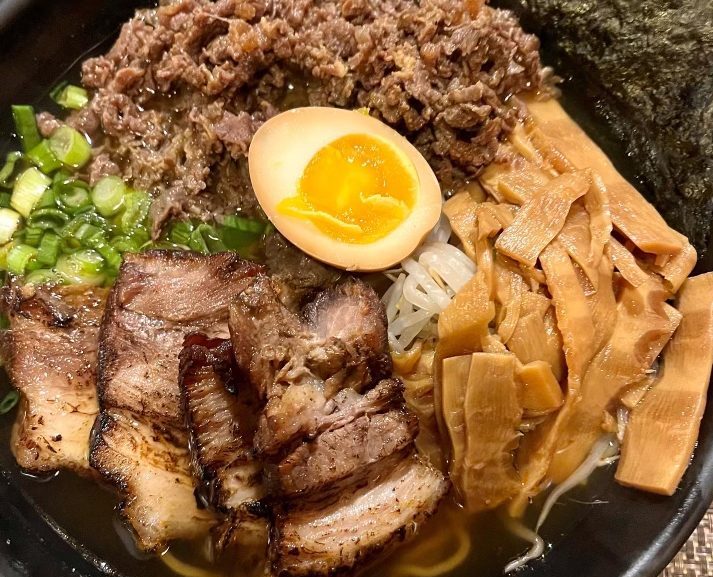It’s time to slurp: the best ramen around town
Whether topped with a soft-boiled egg, chopped scallions, nori or all of the above, ramen’s versatility makes it impossible not to enjoy. Looking for the perfect slurp of noodles, I ventured out to find the best ramen in the area.
June 1, 2022
It’s arguably the most comforting meal on a cold, rainy day: Ramen. The Japanese noodle dish — which consists of wheat-based noodles served in a meat-based broth — is the perfect pick-me-up. During long, tiresome classes, the unavoidable thought of coming home to a hot bowl of ramen constantly floods my mind. Whether topped with a soft-boiled egg, chopped scallions, nori or all of the above, the dish’s versatility makes it impossible not to enjoy.
As a self-proclaimed home chef, ramen is one of my favorite meals to cook, and I was reluctant to explore local ramen restaurants instead of enjoying the dish in the comfort of my own kitchen. However, finding the right ramen to review quickly turned difficult, leaving me to choose between the more than 20 ramen restaurants within an eight-mile radius of Whitman. After careful consideration of gas prices, studying for upcoming AP exams and my already rumbling stomach, I decided to visit four Asian-owned restaurants in our community.
At each restaurant, I evaluated the ambiance, the quality of the ramen dish and other factors like wait time. Looking for the perfect slurp of noodles, I ventured out to find the best ramen in the area.
Oki Bowl: (2.8/5)
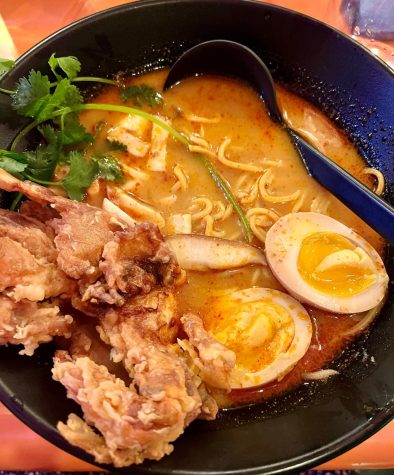
I ordered the Spider Tom Yum ramen with bean sprouts, golden mushrooms and soft shell crab ($17).
My first stop was the critically acclaimed Oki Bowl, nestled on the outskirts of Georgetown. From the outside, Oki Bowl looks like a typical restaurant, but as soon as I stepped inside the narrow-walled eatery, colorful chaos erupted from every direction. Bright green lamp shades hung from the ceiling, dangling alongside birdhouses entangled in vines, while vibrant pieces of cloth lined the walls. After absorbing Oki Bowl’s unique environment, it was time to eat.
The ramen was anything but ordinary. With only six different types of broth to choose from, I went with the Spider Tom Yum, the restaurant’s fan-favorite for seafood lovers like myself. The soup was a lime-based broth — maybe a tablespoon too much lime — with cilantro garnish and a soft shell crab resting atop the noodles. The crab was perfectly crispy and lightly battered with soft, flaky meat inside. The chewier, but slightly thicker wheat-based noodles mixed well alongside the runny soft-boiled egg and mushrooms, but the broth was so acidic that every sip felt like sucking a lime.
While I’d return to Oki Bowl for its upbeat, funky ambiance, I wouldn’t come back for the Spider Tom Yum ramen. Oki Bowl earns a solid 2.8/5.
Sakuramen: (4.2/5)
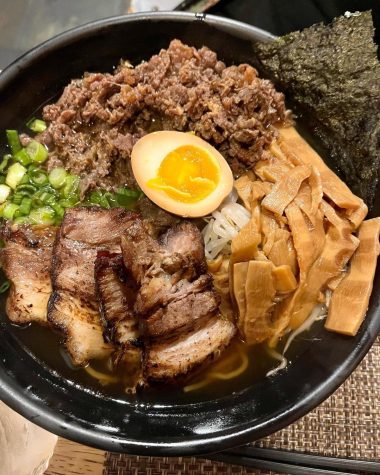
I ordered the Tonkotsu Red with Berkshire pork belly, bamboo shoots, scallions and black garlic oil ($16).
Ranked the ninth-best local ramen restaurant on Yelp, Sakuramen was clearly another must-try eatery, but I had to walk past the restaurant twice before I discovered that I was in the right place. It was only after I noticed a faint “Sakuramen” sign that I realized why it was so difficult to spot: the restaurant was underground. Sakuramen’s rustic and industrial interior compliments the restaurant’s limited natural light. The ambiance was lively — but not too loud — and allowed for a great conversational dining experience.
After 20 long minutes, I finally broke apart my chopsticks and dug into the ramen I had come to assess. My Tonkotsu ramen rested under large chunks of pork belly, a sprinkle of chopped green onions, thin mushrooms and chewy bamboo shoots— a savory combination of textures. The smokey, tender pork belly stained with the black garlic oil complemented the ramen well, but the intensity of the dish’s other flavors made the noodles taste comparatively bland. While I ordered the mild version of the Tonkotsu Red, the broth was also much spicier than I had anticipated. The rich broth was tasty, but I wish I could’ve taken more than two sips of it before trading the dish for a glass of ice water to calm the heat in my mouth.
My dining experience at Sakuramen was both memorable and flavorful. The restaurant served the cheapest ramen of the four locations I visited and gave customers the best “bang for their buck.” Sakuramen earns a well-deserved rating of 4.2/5.
DAIKAYA Ramen Shop: (3.8/5)
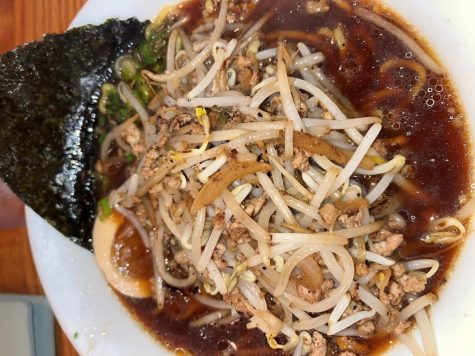
I ordered the SHOYU ramen with dark soy, Chintan stock, toasted garlic, bean sprouts, pork chashu and a seasoned egg ($16.25).
Ranked the top ramen restaurant in D.C., DAIKAYA had a strong reputation to uphold. The aroma of hand-pulled noodles and broth from the restaurant’s open kitchen filled the crowded tables, and I immediately noticed that dozens of “to-go” orders already occupied a spot on a counter at popular eatery by 6:30 p.m.
After waiting 30 minutes, I hoped that the ramen would be worth it. I ordered the restaurant’s most popular ramen, Shoyu, which came topped with a tall pile of onions, bean sprouts and thick slices of pork. The smokey, crunchy mixture added a nice texture to each bite of thick noodles. The dish’s dark, soy-based broth started out delicious, but once I had eaten the toppings, the broth was too salty to finish. I glanced around to find that I wasn’t the only one with this issue; many other customers had also left their broth unfinished.
The smokey and creative toppings at DAIKAYA were a unique addition to the traditional ramen dish, but the broth just doesn’t live up to the restaurant’s top rating. DAIKAYA Ramen Shop comfortably earns a 3.8/5.
JINYA Ramen Bar: (4.6/5)
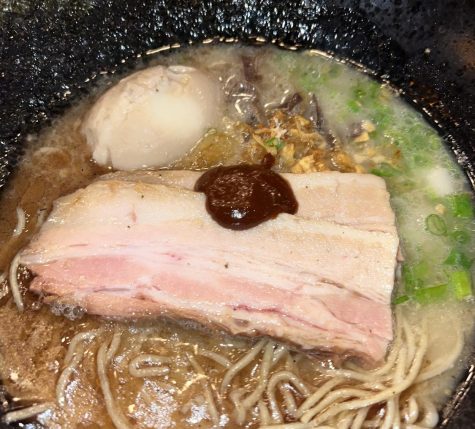
I ordered the JINYA Tonkotsu Black with pork chashu, green onion, dried nori, seasoned egg and garlic chips ($18.90).
Pouring rain and strong winds made me begin to regret my choices as I walked to JINYA Ramen Bar from the parking lot at Pike & Rose. As I approached the eatery, I walked past a long line of customers waiting for a table because as an expert foodie, I had called ahead to reserve my spot on the waitlist.
I ordered the Tonkotsu Black, and there wasn’t a single slurp of noodles I didn’t enjoy. My only complaint is that the dish’s two pork slices tasted like barbeque and didn’t pair well with the other perfected flavors of the dish. After simmering for more than 20 hours, the fatty pork broth was heavy and rich, but somehow light at the same time. The broth was also soothing, but wasn’t as immediately filling as the other Tonkotsu I had eaten.
With the freshest-tasting noodles in the area, it shouldn’t be a surprise that JINYA Ramen rises above the competition with a rating of 4.6/5.



